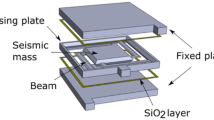Abstract—In the paper, simulation is used to study the thermal deformation of Q-flex accelerometer quartz sensitive element (SE) with technological geometrical deviations of elastic beams with conductors within the operation temperature range. It has been shown that the largest bending moment in the SE appears when conductors from the front and back sides of elastic beam have different thickness and width. A method for static thermal tests simulation has been developed, which allows estimation of accelerometer zero shift with account for the geometrical imperfections of SE elastic beams. It has been revealed that the thermal hysteresis and non-repeatability of accelerometer zero shift are due to the plastic deformation of conductors under near-boundary temperature loads. A SE modification with loose conductors has been developed, which, according to the simulation results, improves the thermal coefficient, hysteresis, and repeatability of zero shift.












Similar content being viewed by others
REFERENCES
Jacobs, E.D., Patent US3702073 (A), G01P15/13, Accelerometer; Sundstrand Data Control Inc. 07.11.1972.
Gao, J., Zhang, K, and Yang, H.-B., Temperature characteristics and error compensation for quartz flexible accelerometer, International Journal of Automation and Computing, October 2015, vol. 12, no. 5, pp. 540−550.https://doi.org/10.1007/s11633-015-0899-5
Minkin, A.M., A quartz glass sensor forming technology by chemical etching using texturized molybdenium coating, Cand. Sci. Dissertation, Perm National Research Polytechnic University, Perm, 2020.
Yang, W., Fang, B., Tang, Y.Y., and Qin, X., A temperature compensation model for low cost quartz accelerometer and its application in tilt sensing, Mathematical Problems and Engineering, 2016, vol. 2016, article ID 2950376. https://doi.org/10.1155/2016/2950376
Birleanu, C., Pustan, M., Merie, V., Müller, R., Voicu, R., Baracu, A., and Craciun, S., Temperature effect on the mechanical properties of gold nano films with different thickness, IOP Conference Series: Materials Science and Engineering, 2016, vol. 147, no. 012021. https://doi.org/10.1088/1757-899X/147/1/012021
Hodge, T., Bidstrup-Allen, S., and Kohl, P., Stress in thin film metallization, IEEE Transactions on Components, Packaging and Manufacturing Technology, June 1997, vol. 20, no. 2, pp. 241–250.
Ghazi, N.E., Investigation of plastic strain recovery and creep in thin film nanocrystalline metals, Graduate School of Arts and Science, Columbia university, 2014.
Baek, C.-W., Kim, J.-M., Kim, Y.-K., Kim, J.H., Lee, H.J., and Han, S.W., Mechanical characterization of gold thin films based on strip bending and nanoindentation test for MEMS/NEMS application, Sensors and Materials, 2005, vol. 17, no. 5, pp. 277– 288.
Pamato, M.G., Wood, I.G., Dobson, D.P., Hunta, S.A., and Vočadlo, L., The thermal expansion of gold: Point defect concentrations and pre-melting in face-centered cubic metal, Journal of Applied Crystallography, 2018, vol. 51, pp. 470–480.https://doi.org/10.1107/S1600576718002248
Glass: Selected Properties and Crystallization, Schmelzer, J.W.P., Ed., Berlin-Boston: Walter de Gruyter GmbH, 2014. https://doi.org/10.1515/9783110298581
Denisov, S.Yu. and Akilin, V.I., Technological methods for improving the accuracy of quartz accelerometers, Navigatsiya i upravlenie letatel’nymi apparatami, 2016, no. 15, pp. 17–31.
Hanson, R.A. and Atherton, K.W., Pat. US4400979 (A), G01L1/00; G01L1/14; G01L1/26; G01P15/13, Force transducer flexure with conductors on surfaces in the neutral bending plane, Sundstrand Data Control Inc., 30.08.1983.
Konovalov, S.F., Mayorov, D.V., Ponomarev, Yu.A., Chulkov, V.E., Semenov, A.E., and Kharlamov, M.S., Patent RU2731652 (C1), G01P15/135, Pendulum force-rebalance accelerometer, № RU20190107343; Byulleten, 2020, no. 25.
Konovalov, S.F., Mayorov, D.V., Semenov, A.E. Ponomarev, Yu.A., Chulkov, V.E., Malykhin, A.A., Kharlamov, M.S., and Malykhin, D.A., Temperature drift and instability of a zero signal of pendulum servo accelerometer, 27th St. Petersburg International Conference on Integrated Navigation Systems, St. Petersburg: Elektropribor, 2020.
Bom, S.J., Parameter optimization and operation mode modeling for Q-flex and Si-flex force-rebalance accelerometers, Cand. Sci. Dissertation, Moscow, 2012.
Luchkin, A.G., Thermal mode of applying thin film coatings to polymers by sputter deposition, Vestnik Kazanskogo tekhnologicheskogo universiteta, 2011, vol. 16, 2011. pp. 121−125.
Author information
Authors and Affiliations
Corresponding author
Rights and permissions
About this article
Cite this article
Barbin, E.S., Kozlov, D.V., Konovalov, S.F. et al. Simulating the Effect of Quartz Sensor Thermal Deformation on Q-Flex Accelerometer Zero Shift. Gyroscopy Navig. 13, 36–43 (2022). https://doi.org/10.1134/S2075108722010035
Received:
Revised:
Accepted:
Published:
Issue Date:
DOI: https://doi.org/10.1134/S2075108722010035




